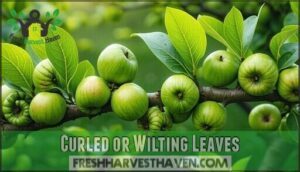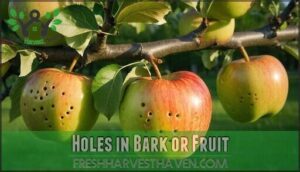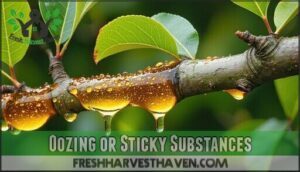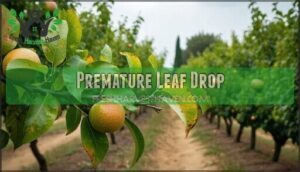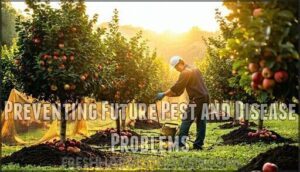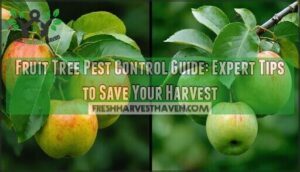This site is supported by our readers. We may earn a commission, at no cost to you, if you purchase through links.
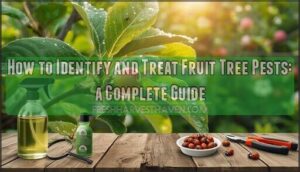
The trick isn’t just reacting when you spot damage; it’s knowing what to look for, catching problems early, and treating them with precision before they compromise your harvest. Whether you’re dealing with soft-bodied pests, boring larvae, or fungal infections that spread on spring winds, effective management hinges on accurate identification and timely intervention.
Table Of Contents
- Key Takeaways
- Common Fruit Tree Pests and Diseases
- How to Identify Fruit Tree Pest Damage
- Step-by-Step Pest Monitoring Techniques
- Effective Treatment Options for Infested Trees
- Preventing Future Pest and Disease Problems
- Frequently Asked Questions (FAQs)
- How to get rid of pests on fruit trees?
- How to identify fruit tree diseases?
- How do you identify tree pests?
- What does Epsom salt do for fruit trees?
- How to identify diseases in fruit trees?
- How often should I spray neem oil on fruit trees?
- Are there non-toxic pest control options available?
- How can seasonal weather impact pest activity?
- What role do ants play in pest infestations?
- Can over-fertilizing make trees more pest-prone?
- Conclusion
Key Takeaways
- Early detection is critical because fruit tree pests and diseases escalate rapidly—what starts as a single aphid can become hundreds within three weeks, making weekly visual inspections and strategic trap placement essential for catching infestations before they compromise your harvest.
- Accurate identification drives effective treatment since different pests require targeted approaches: aphids respond to insecticidal soap and natural predators, while codling moths need pheromone disruption and precisely timed sprays, and fungal diseases like apple scab demand preventative fungicide applications starting at bud break.
- Prevention through resistant varieties and cultural practices delivers measurable results—planting disease-resistant cultivars like ‘Liberty’ apples cuts pesticide use by 30-50%, while proper spacing, pruning for airflow, and prompt debris removal eliminate the conditions where pests and diseases establish themselves.
- Integrated pest management combining biological controls, organic sprays, and strategic chemical use when necessary outperforms single-method approaches, with beneficial insects like ladybugs and lacewings providing ongoing suppression while targeted treatments address severe outbreaks without harming helpful species.
Common Fruit Tree Pests and Diseases
Fruit trees face threats from both pests and diseases that can damage leaves, fruit, and bark if left unchecked. Knowing what you’re dealing with is the first step toward protecting your trees and salvaging your harvest.
Below, you’ll find the most common culprits you’re likely to encounter in your orchard.
Aphids
Among insect pests on fruit trees, aphids rank high for their ability to multiply rapidly and weaken young growth. These soft-bodied insects cluster on tender shoots and leaf undersides, sucking plant sap and excreting honeydew that attracts ants and encourages sooty mold. You’ll recognize their presence by curled, distorted foliage.
Natural predators like ladybugs help control populations, though systemic insecticides may be needed for severe infestations affecting the aphid lifecycle.
Different species, such as the mealy plum aphid, can be identified by their unique characteristics.
Apple Maggots
Apple maggot adults emerge in summer, laying eggs beneath fruit skin through punctures that create dimpled scars. As larvae develop inside, they tunnel throughout the flesh, leaving brown trails that make apples inedible—classic fruit damage symptoms you’ll spot at harvest.
For pest identification, monitor with red ball sticky traps starting in late June, adjusting timing based on regional variations in the maggot life cycle.
Organic control includes removing fallen fruit promptly and bagging individual apples, while trapping methods help reduce populations before insect pests cause widespread damage. These pests are most active during late July and August.
Codling Moths
Codling moth larvae cause the telltale "wormy apple" problem, burrowing deep into fruit from blossom or stem ends. The codling lifecycle produces two or three generations per season, with spring adults emerging as trees bloom—timing that makes early intervention critical.
You’ll recognize fruit damage as entry holes plugged with frass and internal tunneling that ruins entire harvests. Moth trapping using pheromone lures helps monitor adult activity and time organic control applications effectively.
Pheromone confusion products disrupt mating by saturating orchards with synthetic scents, reducing egg-laying without insecticides. These insect pests primarily target apples and pears, making pest control essential for quality fruit production across most fruit trees.
Japanese Beetles
Japanese beetles chew through leaves, creating a lace-like skeleton pattern that distinguishes them from moth damage. Adult beetles feed on foliage and fruit during their four-to-six-week beetle life cycle each summer, while grubs damage roots below ground.
Damage assessment involves checking leaves for characteristic skeletonization and fruit for surface scarring. Trapping methods using floral or pheromone lures can monitor populations, though traps sometimes attract more beetles than they catch.
Natural predators like parasitic wasps and birds provide biological pest control, while targeted insecticides offer chemical controls when infestations threaten fruit trees. Effective pest management balances these approaches for sustainable insect pest suppression.
Spider Mites
Spider mites aren’t insects—they’re eight-legged arachnids that puncture leaf cells, extracting nutrients and leaving stippled, bronze-colored foliage behind. These tiny pest infestations thrive in hot, dry conditions, creating fine webbing signs across leaves and stems that signal severe population levels.
Your pest management strategy should include:
- Mite identification through careful inspection of leaf undersides, where colonies cluster and feed
- Treatment thresholds monitoring to determine when predatory mites or insecticides become necessary
- Resistant varieties selection combined with regular water sprays that disrupt mite populations naturally
Strong water blasts dislodge colonies, while horticultural oils and sulfur-based pest control products target severe outbreaks without harming beneficial predatory mites that provide biological suppression.
Fireblight
Fireblight is one of the most destructive bacterial diseases of fruit trees, particularly threatening apple and pear orchards with economic impacts exceeding $100 million annually in the United States alone. This bacterial infection spreads rapidly during warm, humid spring weather, especially following rainfall or hailstorms.
You’ll recognize fireblight symptoms by wilted shoots that look scorched, blackened foliage resembling fire damage, and sticky amber ooze seeping from bark—all signs demanding immediate attention.
Treatment methods include pruning infected branches at least 12 inches below visible damage and applying preventative streptomycin sprays during bloom, which provide up to 75% disease prevention when timed correctly.
Powdery Mildew
Powdery Mildew appears as white, dusty patches coating leaves and fruit across all fruit tree species, thriving in warm days and cool nights with moderate humidity. You’ll spot this fungal disease starting in spring, with environmental factors like poor air circulation accelerating its lifecycle.
Treatment timing matters—apply sulfur-based fungicides at first symptoms or select resistant varieties during planting. Regular monitoring helps you catch disease symptoms and signs early, preventing the weakened growth and premature fruit drop that follow untreated fungal diseases of fruit trees.
Apple Scab
Apple scab creates olive-green to black spots on fruit and leaves, marking one of the most common fungal diseases of fruit trees affecting apples specifically. The disease cycle begins in spring when spores disperse from overwintered leaf debris during wet conditions, with spore dispersal continuing throughout humid periods.
You’ll notice disease symptoms escalating to premature leaf drop and weakened trees if left unchecked. Controlling apple scab requires preventative sprays with fungicides starting at bud break, combined with selecting resistant cultivars during planting—this dual approach disrupts scab identification problems while maintaining tree vigor.
Cedar Apple Rust
When fungal diseases jump between host species, Cedar Apple Rust demonstrates this pattern by requiring both apple and juniper trees to complete its lifecycle. Red-black spots appear on apple leaves, with visible spores underneath, indicating active infection. Disease identification starts with recognizing the distinctive spotted pattern on foliage.
Control this fruit tree disease through:
- Remove nearby juniper hosts within a few hundred feet
- Apply fungicides during spore dispersal periods in spring
- Select rust-resistant apple varieties when planting
- Monitor for orange lesion appearance on fruit
- Prune to improve air circulation as preventative measures
How to Identify Fruit Tree Pest Damage
Catching pest damage early can save your tree, and sometimes the whole season’s harvest. The signs aren’t always obvious at first glance, but once you know what to look for, they tell a clear story.
Here are the key symptoms that signal your fruit tree is under attack.
Curled or Wilting Leaves
When your fruit tree’s leaves start curling inward, twisting unnaturally, or drooping, you’re looking at one of the clearest signs that pests have moved in. Aphids are usually the culprits behind leaf curl causes, though viral infections, nutrient deficiencies, and watering issues can also trigger similar disease symptoms.
Check the undersides of affected leaves for insect pests or identifying leaf spots that signal fungal problems. Untreated defoliation from root problems weakens trees considerably over time.
Honeydew and Sooty Mold
If you’ve noticed a shiny, sticky film coating your tree’s leaves and branches, aphids and other sap-sucking insects are likely feeding overhead and leaving behind honeydew as waste. This honeydew identification leads to sooty mold growth, a black fungal disease that blocks sunlight and weakens tree health.
Ant interactions often follow since ants farm aphids for honeydew. Treatment strategies include washing foliage, applying insecticidal soap for pest control, and addressing the underlying insect pests.
Prevention tips focus on early disease management and maintaining proper air circulation.
Discolored or Scarred Fruit
Crescent-shaped punctures, rusty brown patches, or dimpled skin on your harvest don’t just look unappealing—they signal specific pests have already made your fruit their home.
Plum curculio causes distinctive scar formation and punctured skin, while codling moths create fruit damage that leads to rotting fruit from the inside out. Apple maggots produce fruit blemishes and deformed fruit with characteristic dimpling.
These disease symptoms and insect damage patterns help you identify which pest you’re dealing with, making treatment more targeted and effective.
Holes in Bark or Fruit
Tiny holes drilled into bark or tunnels winding through fruit tell you that borers or larvae have moved in and are feeding beneath the surface where you can’t easily reach them. Borer identification starts with checking entry points near the trunk, while curculio damage appears as crescent-shaped wounds in fruit flesh. Rodent chewing leaves ragged, larger holes compared to precise insect damage.
These insect infestations create pathways for secondary infections, turning minor fruit damage by insects into serious tree decline if left unchecked.
Oozing or Sticky Substances
Sticky amber ooze dripping from bark or a clear, glistening film coating leaves signals that something—whether insects secreting honeydew or disease causing gummosis—is actively compromising your tree’s health.
Bacterial ooze from fireblight creates sticky, amber-colored droplets near cankers, while gummosis symptoms appear as thick sap flux from wounded bark.
Honeydew identification involves checking for a shiny coating produced by insect pests like aphids, often accompanied by black sooty mold, insect frass, or distorted galls where disease symptoms converge with pest activity.
Premature Leaf Drop
When leaves carpet the ground weeks ahead of harvest, your fruit tree isn’t preparing for autumn—it’s waving a red flag that disease or severe pest damage has pushed it past its stress threshold. Identifying fruit tree pests behind defoliation requires examining several root causes:
- Fungal leaf spots from apple scab or rust trigger premature shedding
- Water stress and nutrient deficiencies weaken disease resistance
- Environmental factors including poor root health compound viral infections
- Severe infestations accelerate leaf drop before natural dormancy
Step-by-Step Pest Monitoring Techniques
Catching pest problems early makes all the difference between a healthy harvest and a season of frustration. The key is setting up a simple monitoring routine that helps you spot trouble before it spreads.
Here’s how to keep a close eye on your trees throughout the growing season.
Regular Visual Inspections
The best defense against fruit tree pests starts with a simple habit: walking around your trees at least once a week to catch problems before they spiral out of control. Inspection frequency matters most during active growing seasons when pests multiply quickly.
Look closely at leaf undersides, new growth, and fruit surfaces for early detection of signs like discoloration or unusual spots. Record findings in a simple notebook—timing matters when identifying insect and disease pests, and written observations help you recognize patterns before disease symptoms in fruit trees become severe.
Using Sticky and Pheromone Traps
Beyond visual checks, traps add precision to your pest monitoring approach. Pheromone traps work through trap specificity—targeting codling moth or oriental fruit moth by mimicking mating signals—while yellow sticky traps catch various insects indiscriminately, affecting environmental impact by capturing beneficial species alongside pests.
Placement strategies matter: hang pheromone traps six to seven feet high, positioning two per orchard for reliable monitoring metrics.
These tools support IPM integration by identifying pests and diseases early, guiding your pest management strategies and insect pest control decisions without immediate chemical use, managing fruit tree health through informed pest monitoring.
Fruit and Leaf Sampling
Sampling fruits and leaves directly from your trees reveals problems that traps and visual scans often miss, like internal larvae or early-stage fungal infections hiding beneath surfaces. Proper technique and sample timing determine accuracy when identifying pests and diseases.
- Sample multiple trees at different heights, examining 10-15 fruits and leaves per location for representative data interpretation
- Cut open suspicious fruit to expose larvae stages inside, confirming common fruit tree pests like codling moth or apple maggot
- Check leaf undersides carefully for spider mites, aphid colonies, or disease symptoms in fruit trees
- Consider lab analysis for complex fruit tree diseases requiring precise identification before treatment
Monitoring for Disease Symptoms
Disease symptoms don’t announce themselves with fanfare—they sneak in gradually, turning a healthy canopy into a warning flag if you know where to look. Early detection requires weekly checks focusing on leaf discoloration, wilting patterns, and bark abnormalities that signal disease symptoms in fruit trees.
Environmental factors like humidity and temperature accelerate symptom progression, making timing critical for fruit tree disease diagnostics.
Digital monitoring through photographic documentation helps track changes you might otherwise miss, improving your fruit tree disease management strategy.
Keeping Records of Pest Activity
Your observation notes become the investigative file that reveals patterns invisible in single moments—tracking pest activity over time transforms scattered clues into actionable intelligence.
Recordkeeping benefits include identifying action thresholds that trigger spray schedules, analyzing historical trends to anticipate pest life cycles and disease cycles, and refining integrated pest management strategies.
Your data analysis reveals which cultural practices actually work, turning guesswork into targeted pest monitoring that protects your trees efficiently.
Effective Treatment Options for Infested Trees
Once you’ve spotted the problem, it’s time to act. The right treatment depends on what you’re dealing with—whether it’s insects chomping away, fungal diseases spreading, or bacterial infections taking hold.
Here are the most effective approaches to get your trees back on track.
Pruning Infested Branches
Cutting away diseased limbs isn’t just about aesthetics—it’s a surgical strike that stops infection from spreading through your entire tree.
Pruning infected branches is a surgical strike that halts disease spread through your tree
You’ll need to sterilize your pruning tools between each cut using rubbing alcohol or bleach solution, which prevents transferring pathogens to healthy branches. Make clean cuts at least six inches below visible damage, then apply wound treatment to exposed areas and burn or bag infected material immediately.
Removing and Disposing of Infested Fruit
After you’ve pruned away damaged branches, any fruit still hanging on the tree that shows signs of infestation needs to come off—leaving it there just invites pests to multiply and reinfect your entire orchard. Check for fruit rot, fruit malformation, and entry holes that signal fruit flies or larvae inside.
Bag everything in sealed plastic before disposal—never compost diseased material, as it’ll spread fruit rot diseases. Destroy infested fruit promptly to break the pest lifecycle and prevent spread throughout your property.
Applying Organic Sprays (Neem Oil, Soap)
Once you’ve cleared away the bad fruit, organic sprays like neem oil and insecticidal soap can knock down soft-bodied pests without leaving harsh chemical residues on your harvest. Apply them in early morning or evening to avoid burning foliage, and follow these application best practices:
- Mix neem oil at 2 tablespoons per gallon of water for aphids and mites
- Spray insecticidal soap directly on pest bodies for contact elimination
- Reapply every 7-10 days until your home orchard shows improvement
These organic pest control methods work best when you catch infestations early.
Using Insecticidal and Fungicidal Treatments
When organic sprays fall short, synthetic insecticides and fungicides offer more robust pest control, but the timing of application is crucial. For plum curculio, two post-flowering treatments are most effective. Pre-monsoon fungicide application significantly reduces fruit rot severity by 75–87%, underscoring the importance of early intervention for optimal treatment efficacy.
| Treatment Type | Active Ingredient | Application Timing | Efficacy Result |
|---|---|---|---|
| Insecticide | Chlorpyrifos 0.5 g/L | Post-bloom | 0.21% fruit infestation |
| Insecticide | Diazinon 1 g/L | Delayed dormant | 0.19% scale damage |
| Fungicide | Synthetic injection | Pre-monsoon | 75–87% disease reduction |
| Fungicide | Trunk injection (4×) | Seasonal intervals | 133-day residue retention |
Effective resistance management involves rotating chemical families. For instance, thiamethoxam resistance decreased when growers alternated products. Additionally, canopy-based dosage reduction achieved a 60.7% decrease in pesticide use while maintaining control thresholds, demonstrating that strategic application methods outperform blanket spraying for safer pesticide use.
Introducing Beneficial Insects
While synthetic chemicals have their place, your best allies in pest control often crawl right through your orchard—ladybugs, lacewings, and parasitic wasps tackle aphids, mites, and caterpillars without leaving a trace of harmful residue.
Predator introduction works best when you create habitat that sustains these natural enemies, a cornerstone of IPM integration.
Plant native flowering species nearby to attract pollinators and beneficial insects, transforming your orchard management approach into sustainable fruit tree pest control.
Biological Control Methods
Harnessing natural enemies—from bacteria to fungi to predatory nematodes—lets you disrupt pest life cycles without ever reaching for a spray bottle. These microbial pesticides and beneficial nematodes target specific pests while leaving fruit trees unharmed, making them ideal for organic pest control methods. Conservation biocontrol strengthens this approach by protecting existing predator populations through thoughtful orchard management.
Five biological control strategies for identifying pests and diseases:
- Deploy parasitoid wasps that lay eggs inside aphids and caterpillars
- Apply Bacillus thuringiensis (Bt) for caterpillar control on fruit trees
- Release beneficial nematodes into soil to attack root-feeding larvae
- Use entomopathogenic fungi like Beauveria bassiana against beetles
- Maintain hedgerows for predator introduction and habitat conservation
Preventing Future Pest and Disease Problems
Once you’ve treated an active infestation, the real work begins: keeping your trees healthy enough to resist future problems. Prevention isn’t a one-time fix—it’s a combination of smart choices and consistent habits that create an environment where pests and diseases struggle to take hold.
Let’s look at the most effective strategies you can use to protect your fruit trees year after year.
Choosing Resistant Varieties
One of the smartest moves you can make is planting resistant fruit tree varieties from the start. Cultivars like ‘Liberty’ apples or Italian prune plums naturally fend off common diseases, slashing pesticide use by 30–50% and boosting marketable yields by roughly 27%.
Regional performance matters—matching your hardiness zone increases survival by up to 18%.
Genetic diversity in mixed orchards cuts pest outbreaks by 15–25%, demonstrating how integrated approaches strengthen tree health while delivering real economic benefits over time.
Proper Tree Care and Watering
Consistent watering and basic maintenance aren’t just chores—they’re your frontline defense against stressed trees that attract pests like magnets. Healthy soil conditions and root health determine whether your tree thrives or struggles:
- Deep watering once weekly beats shallow daily sprinkles, encouraging stronger roots
- Mulching benefits include moisture retention and temperature regulation around the root zone
- Nutrient management through soil testing prevents deficiencies that weaken immunity
- Air circulation improves when you maintain proper spacing and tree care routines
Regular Pruning and Debris Removal
Pruning isn’t just about shaping your tree—it’s about cutting off the hiding spots and breeding grounds where pests and diseases take hold. Remove diseased or dead tree branches during the dormant season using sanitized pruning tools dipped in diluted bleach between cuts.
Proper pruning techniques for fruit trees create airflow improvement while eliminating infection sites.
Don’t leave fallen leaves and fruit lying around—prompt debris disposal stops pathogens from overwintering and reinfecting your orchard next season.
Maintaining Air Circulation
Good air circulation around your fruit trees works like a natural defense system, keeping foliage dry and making it harder for fungal spores and disease-causing bacteria to establish themselves.
Space trees adequately at planting—usually 15 to 20 feet apart—and use proper pruning techniques for fruit trees to reduce branch density.
These preventative measures guarantee airflow benefits reach the tree’s interior, strengthening plant health while limiting conditions that favor powdery mildew and similar diseases.
Creating Beneficial Insect Habitats
Inviting ladybugs, lacewings, and parasitic wasps into your orchard creates a living pest-control team that works around the clock without chemicals. You’ll strengthen plant health and fruit production by establishing habitat diversity with these preventative measures:
- Plant native flowering species that bloom throughout the growing season
- Create pollinator gardens near fruit trees
- Provide shallow water sources like birdbaths with stones
- Leave some leaf litter and mulch for shelter
- Avoid broad-spectrum pesticides that harm beneficial insects
Attracting predators through environmental factors ensures sustainable pest control services naturally.
Safe Use of Pesticides and Alternatives
When beneficial insects can’t keep up with severe infestations, knowing how to use pesticides responsibly—or skip them entirely—protects both your harvest and the helpful creatures you’ve worked to attract.
Always read the pesticide label thoroughly, wear protective clothing during application, and consider organic alternatives like horticultural oils or insecticidal soaps.
IPM strategies prioritize targeted treatments that minimize environmental impact, keeping organic growers’ orchards productive while preserving beneficial populations.
Frequently Asked Questions (FAQs)
How to get rid of pests on fruit trees?
Start with IPM strategies that combine biological, cultural, and chemical controls. Organic pest-control methods like neem oil target pests while natural predators—beneficial insects—provide ongoing protection.
Preventative measures include proper pruning and choosing resistant varieties for effective tree pest management.
How to identify fruit tree diseases?
Fungal diseases whisper secrets through spotted leaves, while bacterial symptoms shout through oozing cankers.
Disease diagnosis starts with leaf analysis—checking for discolored patches, unusual textures, or premature wilting. Look for signs like powdery coatings, rust-colored spots, or blackened tissue that signal disease progression and help you identify plant diseases accurately.
How do you identify tree pests?
Examine leaves, bark, and fruit for visible signs like holes, discoloration, or sticky residue that indicate insect pests or larvae presence.
Pest identification keys and lifecycle pest stages help pinpoint specific threats to your fruit trees.
What does Epsom salt do for fruit trees?
Epsom salt provides magnesium sulfate, which improves nutrient absorption rates in fruit trees experiencing deficiency symptoms like yellowing leaves.
Foliar spray effectiveness depends on soil health and existing soil pH balance—recommendations suggest testing before application.
How to identify diseases in fruit trees?
Disease symptoms often reveal themselves through visual clues like discolored spots, wilting foliage, or sticky ooze on bark.
Fungal identification relies on recognizing white powdery coatings or rust-colored pustules, while bacterial diseases commonly cause blackened, fire-scorched appearances on branches and leaves.
How often should I spray neem oil on fruit trees?
Apply neem oil every 7–14 days during active pest activity, adjusting for weather and tree species variations. Rain reduces effectiveness, requiring reapplication.
Target early morning or evening to avoid leaf burn and boost pesticide efficacy in treating fruit tree diseases.
Are there non-toxic pest control options available?
Yes, you’ve got a bounty of safe choices! Organic pesticides like neem oil, insecticidal soaps, and homemade remedies offer ecofriendly options for home orchard pest control.
Beneficial insects and safe pesticide application support sustainable agriculture and organic gardening for long-term prevention.
How can seasonal weather impact pest activity?
Temperature effects and rainfall influence determine when insect pests of fruit trees become active. Humidity impact promotes fungal disease pests, while seasonal life-cycles mean certain pests emerge predictably.
Climate change is altering traditional patterns for managing fruit tree pests.
What role do ants play in pest infestations?
Ants don’t directly harm fruit trees, but they fiercely defend honeydew-producing aphids from predators, creating an ant-aphid symbiosis that worsens infestations.
This honeydew farming by ants protects plant pests, making orchard pests harder to control and indirectly damaging fruit tree pest management efforts.
Can over-fertilizing make trees more pest-prone?
Excess fertilizer creates soft, succulent growth that attracts aphids and other sap-feeders. Nutrient imbalance from over-fertilizing weakens your tree’s natural defenses, making it more susceptible to plant pests and disease while disrupting soil health.
Conclusion
Think of your orchard as a living system where early vigilance acts like an immune response—catching threats before they spread protects the whole.
Learning to identify and treat fruit tree pests isn’t about being flawless; it’s about building the habit of observation, acting decisively when symptoms appear, and refining your approach season by season.
The more familiar you become with the rhythms of damage and recovery, the less intimidating these challenges feel, and the more resilient your trees become.

